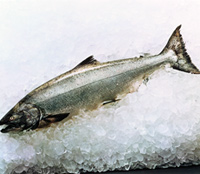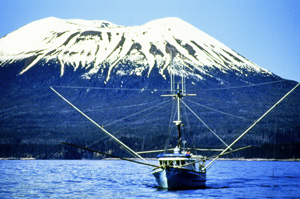King Salmon |

Alaskan King Salmon King Salmon (Oncorhynchus tshawytscha), also known as Chinook, are the largest and rarest species of salmon in Alaska. Wild King Salmon have been known to grow to well over 100 pounds. The current record king salmon catch on rod and reel is 97 lbs. caught from Alaska's famous Kenai River, however larger wild specimens have been harvested in commercial nets, including one caught in a fish wheel in Southeast Alaska that tipped the scales at 126 lbs. Chinook salmon are highly prized by both sport and commercial fishermen because of their sheer size, but also for their tasty red-orange flesh that is loaded with healthy Omega 3 fatty acids. King Salmon Life CycleJuvenile kings hatch from eggs deposited by mature females in fresh water stream beds. The female guards her nest (or redd) until she dies days or weeks after spawning. From the fertilized egg, salmon undergo 3 larval stages of development prior to becoming a recognizable salmon fry. These wild salmon fry spend between 3 months to 2 full years in fresh water before entering the ocean. The amount of time spent in fresh water is determined genetically. King salmon fry are generally classified as "stream type" or "ocean type" depending on the length of time they stay in fresh water. Prior to entering the ocean as smolt, king salmon undergo physiological changes which allow their gills to function in saltwater. Additionally, changes in coloration transform their sides to bright silver with a white belly, and greenish/blue color along the top with small black spots. This coloration helps protect the smolt upon entering the ocean. Gone are the dark vertical stripes (or parr marks) originally present to camouflage young fry in fresh water. Wild king salmon usually spend between 2 and 5 years in saltwater. During this time they feed on a variety of marine organisms such as shrimp, krill, herring, sandlance, and crabs. Chinook salmon grow quickly, especially during the bountiful summer season, when they may double in size. After covering wide reaches of open ocean, mature king salmon re-enter the river system from which they were hatched to spawn and complete their life cycle. White King SalmonOccasionally, fishermen catch king salmon with ivory colored flesh instead of the more typical red-orange color. These fish are often referred to as "white kings" or "ivory kings". They are highly regarded for their delectably mild flavor, though their flesh has been shown to contain nearly identical amounts of protein, fat, and healthy Omega 3's. The occurrence of Chinooks with white flesh was phenomenon not fully understood until recently. Many believed the white flesh was caused by the diet of that individual fish, possibly after it had been feeding in deep water on a more "non-traditional" diet. The normal diet of a king salmon contains various red/orange colored marine organisms such as krill, shrimp, and crab. 
A commercial salmon troller plies the waters of SE Alaska. Through further study, biologists have found that white king salmon are more or less a genetic anomaly. These fish lack the ability to metabolize astaxanthin, a carotenoid pigment found in most shellfish. This inability to store pigment in their muscle tissue leaves the flesh without its normal coloration. This recessive trait is passed from parent to offspring and prevails in many rivers of Southeast Alaska and British Columbia, where concentrations of white king salmon are comparably high. Regardless of the reason, this rare white-fleshed salmon is highly regarded by many award winning chefs and knowledgeable diners for its unique appearance and mild flavor.
Sustainability:In Alaska the sustainability of wild seafood and fish species is taken very seriously. When it comes to Alaskan King Salmon, runs are closely monitored to prevent over harvest and to allow sufficient escapement levels of spawning adults into each river system to ensure viability of future runs, year after year. Wild Alaskan Salmon have been certified as a sustainable seafood species by the Marine Stewardship Council. Additionally, the Monterey Bay Aquarium's Seafood Watch rates wild Alaskan salmon at the top of the list of sustainable alternatives for salmon consumers. For additional information see Alaska Seafood Marketing Institute's Alaska Salmon Buyer's Guide. |
Alaska Fishing Charters
Captain Jack's is located on the docks in Seward, Alaska. Having a first-hand look at each catch, we know which Seward fishing charters routinely find the fish. We can point you in the right direction to tip the scales in your favor.
Share Your Recipe
Share your favorite seafood recipes with us and earn 500 JACKpot Reward Points for each one!

Our Fish Fly First Class
Captain Jack's Seafood Locker ships your freshly-frozen Alaska Seafood via UPS overnight delivery, directly from our freezer to your front door. This ensures that when you order Alaskan seafood from Captain Jack's it arrives in perfect condition on the day you choose.
Pardon our website, we are currently working on updates! Captain Jack's is currently shipping with UPS to get your product to you in the best condition, the fastest way possible. For any questions on shipping, please call 907-224-8082.



